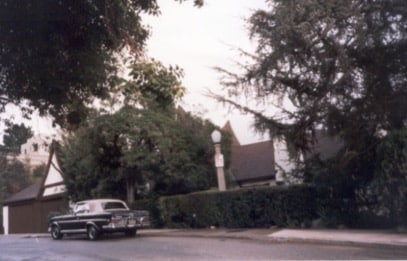
2574 N. Glendower Avenue 90027 - Hlaffer-Courcier Residence
2574 N. Glendower Avenue 90027 Los Feliz USA
Type
Historic-Cultural Monument, Storybook
Sold
Bedrooms
3 Bedrooms
Bathrooms
2 Baths
Area
2,298 sqft
About
“Hlaffer-Courcier Residence”
Los Angeles Historic-Cultural Monument #1069 (6/24/2014)
Rufus Buck, architect.
Click here to see the Los Angeles Department of City Planning Recommendation Report, which has additional details on the property’s architectural and historic significance.
“Note the sinister, snaking timbers and creepy, upturned roof.” Photo of house in “Day Dream Houses of Los Angeles”, Charles Jencks, Rizzoli, N.Y., 1978, p.70.
Built in 1923, this two-story single family residence has the character-defining features of the Storybook style. The historic-cultural monument home was designed and built for Lulu E. Hlaffer and Rufus Buck, who built other storybook residences in Los Angeles. The longest residents of the house were John and Irene Courcier. They purchased the property in 1933 and lived there until 1999. (Source: Los Angeles Department of City Planning recommendation Report).
1930 census:
2574 Glendower Avenue (Rents for $100 per month): 1930 census: 1) Susie M. Bratzler, renter and head of household; 36 year old white female widow; married at age 23; born in Illinois; father born in Scotland, mother in Illinois; not working.
1940 Census:
2574 Glendower Avenue (Value $11,000): 1) John L. Courcier, head of household; white married male 39 years of age; born in Illinois; a raw film salesman; earns more than $5,000). 2) Irene B. Courcier, wife; white married female 42 years of age; born in England; not working. 3) Brian Courcier, son; white male 13 years of age; born in California; in school. 4) Patricia Courcier, daughter; white female 12 years of age; born in California; in school. 5) Susie D. Compton, servant; Negro divorced female 27 years of age; born in Louisiana; a maid in a private home; earns $480.
About Storybook: The storybook style is a nod toward Hollywood design technically called Provincial Revivalism and more commonly called Fairy Tale or Hansel and Gretel. While there is no specific definition of what makes a house storybook style, the main factor may be a sense of playfulness and whimsy. Most seemed snapped out of a craggy old-world village with intentionally uneven roofs, many cobblestone, doors and windows which may look mismatched and odd-shaped. It took a foothold in California, particularly in Los Angeles, during the 1920s and 1930s. (Source: Wikipedia)
Details
Type: Historic-Cultural Monument Sold
Bedrooms: 3
Area: 2,298 sqft
Lot Size: 11,000 sqft
Bathrooms: 2
Year Built: 1924
